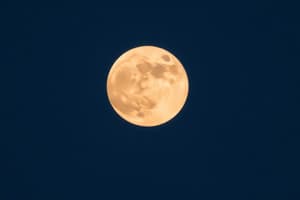Podcast
Questions and Answers
Why does the distance between the Earth and Moon vary?
Why does the distance between the Earth and Moon vary?
- The Moon's orbit around the Earth is elliptical, resulting in varying distances between the two bodies. (correct)
- The combined gravitational forces of other planets in the solar system affect the Moon's orbit.
- Atmospheric conditions on Earth distort the perceived distance to the Moon.
- The Earth's orbit around the sun is elliptical, causing variations in its gravitational pull on the Moon.
Which of the following statements correctly contrasts a supermoon at perigee with an average full moon?
Which of the following statements correctly contrasts a supermoon at perigee with an average full moon?
- A supermoon at perigee can appear up to 14% larger and 30% brighter than an average full moon. (correct)
- A supermoon at perigee has no noticeable difference in size or brightness compared to an average full moon.
- A supermoon at perigee appears smaller and dimmer than an average full moon.
- A supermoon at perigee occurs when the moon is farthest from the Earth, unlike an average full moon.
How does the November 2024 supermoon compare to the November 2016 supermoon?
How does the November 2024 supermoon compare to the November 2016 supermoon?
- The November 2024 supermoon was a few thousand miles farther from Earth than the November 2016 supermoon. (correct)
- The November 2024 supermoon occurred at the apogee, while the November 2016 supermoon occurred at the perigee.
- The November 2024 supermoon and the November 2016 supermoon were at approximately the same distance from Earth.
- The November 2024 supermoon was significantly closer to Earth than the November 2016 supermoon.
What is the primary reason the November full moon is often referred to as the Beaver Moon?
What is the primary reason the November full moon is often referred to as the Beaver Moon?
Why do scientists encourage people to take photographs of supermoons?
Why do scientists encourage people to take photographs of supermoons?
Flashcards
What is a supermoon?
What is a supermoon?
A full moon that occurs when the Moon is near its closest approach to Earth.
What is the apogee?
What is the apogee?
The point in the Moon's orbit when it is farthest from Earth.
What is the perigee?
What is the perigee?
The point in the Moon's orbit when it is closest to Earth.
What is the Beaver Moon?
What is the Beaver Moon?
Signup and view all the flashcards
Why does the Moon's distance vary?
Why does the Moon's distance vary?
Signup and view all the flashcards
Study Notes
- The full moon on November 15, 2024, will be the last of four consecutive supermoons.
- This follows the Blue Moon in August, the Harvest Moon in September, and the Hunter Moon in October.
- The next supermoon after this will not occur until October 7, 2025.
- Supermoons can appear up to 14% larger and 30% brighter compared to an average full moon.
- Supermoons happen when a full moon coincides with the lunar perigee.
- Lunar perigee is the Moon's closest point to Earth in its orbit.
- On November 15, 2024, the Moon's distance will be approximately 224,853 miles (361,866 km) from Earth.
- The November 2016 supermoon was closer at 221,524 miles (356,508 km), the closest in recent history.
- The Moon's orbit is elliptical, causing variations in its distance from Earth.
- The apogee is the Moon's farthest point from Earth, at about 253,000 miles (407,164 km).
- At perigee, the Moon averages a distance of about 226,000 miles (363,711 km) from Earth.
- The November full moon is commonly known as the Beaver Moon.
- The name "Beaver Moon" signifies the time when beavers seek shelter in their lodges for the winter.
- The "Beaver Moon" also marked the season for trapping beavers for their winter coats during North America's fur trade.
- Other names for the November full moon include Frost Moon, Freezing Moon, and Digging Moon.
- Claims that supermoons cause earthquakes or tidal waves are not scientifically supported.
Studying That Suits You
Use AI to generate personalized quizzes and flashcards to suit your learning preferences.





